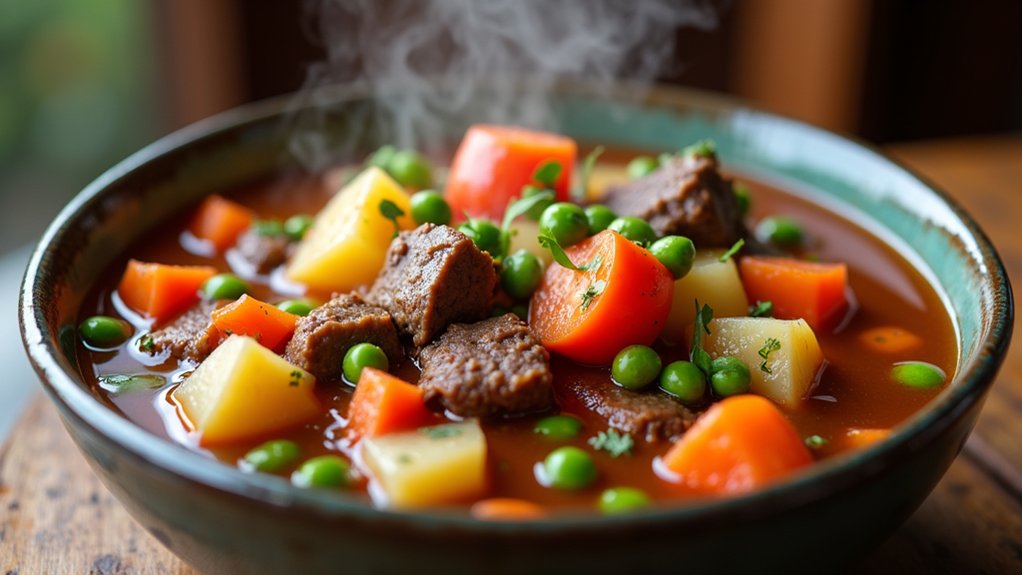There’s something undeniably comforting about a steaming bowl of stew. Growing up, my grandma’s beef stew was a Sunday staple, filling the house with its rich aroma. From zesty chicken and dumplings to hearty clam chowders, these classic American stews have stories and flavors that span generations. Curious to discover which stew might become your new family favorite? Let’s explore these timeless recipes together.
Beef Stew

Beef stew is a quintessential American comfort food that combines hearty ingredients into a deliciously rich and savory dish. With tender chunks of beef, an assortment of vegetables, and a deeply flavored broth, this stew is perfect for warming up on a chilly day. The slow-cooked process allows all the flavors to meld together, resulting in a satisfying meal that can be enjoyed by the whole family.
Whether served on its own or with a side of crusty bread, this classic beef stew is bound to become a favorite in your household. The origins of beef stew are deeply rooted in American cooking traditions, with variations found in homes across the country. This recipe sticks to the classic version, using simple ingredients that are easy to find and prepare.
The key to a great beef stew is giving it enough time to cook slowly, allowing the beef to become tender and the flavors to blend beautifully. It’s a dish that requires minimal hands-on time but delivers maximum flavor and comfort.
Ingredients for a serving size of 4-6 people:
- 2 lbs beef chuck, cut into 1-inch cubes
- 3 tablespoons olive oil
- 1 large onion, diced
- 3 cloves garlic, minced
- 4 cups beef broth
- 2 tablespoons tomato paste
- 1 cup red wine (optional)
- 4 carrots, peeled and sliced
- 3 potatoes, peeled and cubed
- 2 tablespoons Worcestershire sauce
- 2 bay leaves
- 1 teaspoon dried thyme
- Salt and pepper to taste
- 1 cup frozen peas
- 2 tablespoons all-purpose flour
- 2 tablespoons water
- Fresh parsley, chopped (for garnish)
Cooking Instructions:
- Prepare the Beef: Season the beef cubes with salt and pepper. In a large pot or Dutch oven, heat 2 tablespoons of olive oil over medium-high heat. Add the beef in batches, browning each side for about 4-5 minutes. Remove the beef and set aside.
- Sauté Aromatics: In the same pot, add the remaining tablespoon of olive oil. Add the diced onion and sauté for 3-4 minutes until translucent. Stir in the minced garlic and cook for another 1-2 minutes until fragrant.
- Deglaze and Build Flavors: Pour in the red wine (if using) to deglaze the pot, scraping up any browned bits from the bottom. Let it simmer for a few minutes until the wine reduces by half. Stir in the tomato paste until well combined.
- Add Broth and Seasonings: Return the beef to the pot and add the beef broth, Worcestershire sauce, bay leaves, and thyme. Bring the mixture to a boil, then reduce the heat to low. Cover and let it simmer for 1.5 to 2 hours, or until the beef is tender.
- Incorporate Vegetables: Add the carrots and potatoes to the stew. Continue to simmer, covered, for an additional 30 minutes, or until the vegetables are tender.
- Thicken the Stew: In a small bowl, mix the flour and water to create a slurry. Stir it into the stew to thicken the broth. Add the peas and cook for another 5 minutes.
- Final Seasoning and Serve: Taste and adjust the seasoning with salt and pepper as needed. Remove the bay leaves. Serve hot, garnished with chopped fresh parsley.
Extra Tips:
For the best results, choose a well-marbled beef chuck, as it will become tender and flavorful during the long cooking process. If you prefer a thicker stew, you can add more flour to the slurry.
Be patient with the simmering time to guarantee the beef reaches the desired tenderness. If using a slow cooker, you can transfer the sautéed ingredients to the cooker and follow the same steps, cooking on low for 6-8 hours.
This stew can be made a day ahead, as the flavors will continue to deepen overnight. Enjoy your classic beef stew with a side of warm, crusty bread for the ultimate comfort meal.
Chicken and Dumplings
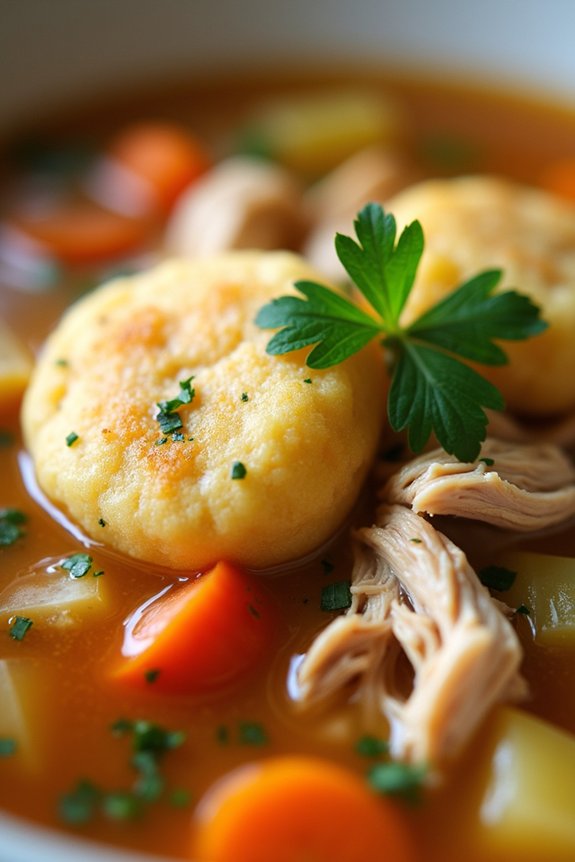
Chicken and Dumplings is a classic American comfort food, perfect for a cozy dinner with family or friends. This dish combines tender chicken simmered in a rich, savory broth with fluffy dumplings that soak up all the delicious flavors. It’s hearty, satisfying, and brings a sense of warmth to any meal.
With its roots in Southern cooking, Chicken and Dumplings has become a beloved staple across the country. The beauty of Chicken and Dumplings lies in its simplicity and the way it brings together basic ingredients to create something truly special. The chicken is cooked until succulent, falling off the bone, while the dumplings are soft and pillowy, making every bite a delightful experience.
This recipe is designed to serve 4-6 people, making it perfect for a family gathering or a simple weeknight dinner. Let’s plunge into the ingredients and the step-by-step process to create this delicious dish.
Ingredients (Serves 4-6):
- 1 whole chicken (about 3-4 pounds), cut into pieces
- 8 cups chicken broth
- 2 cups all-purpose flour
- 1 tablespoon baking powder
- 1 teaspoon salt
- 1/4 teaspoon black pepper
- 1/2 cup milk
- 1/4 cup unsalted butter, melted
- 2 tablespoons vegetable oil
- 2 large carrots, sliced
- 2 celery stalks, sliced
- 1 onion, diced
- 2 garlic cloves, minced
- 2 teaspoons fresh thyme, chopped
- 2 bay leaves
- Salt and pepper to taste
- Fresh parsley, chopped (for garnish)
Cooking Instructions:
- Prepare the Chicken: In a large pot or Dutch oven, heat the vegetable oil over medium-high heat. Add the chicken pieces and brown them on all sides, about 5-7 minutes. Remove the chicken from the pot and set it aside.
- Sauté the Vegetables: In the same pot, add the diced onion, sliced carrots, and celery. Sauté until the onions are translucent and the vegetables are slightly softened, about 5 minutes. Add the minced garlic and cook for an additional minute.
- Simmer the Broth: Return the chicken to the pot. Add the chicken broth, thyme, bay leaves, salt, and pepper. Bring to a boil, then reduce the heat to low. Cover and let it simmer for about 45 minutes or until the chicken is cooked through and tender.
- Make the Dumplings: While the chicken is cooking, prepare the dumplings. In a bowl, mix the flour, baking powder, and salt. Stir in the milk and melted butter until you have a smooth dough. Don’t overmix.
- Cook the Dumplings: Remove the chicken pieces from the pot and set them aside to cool slightly. Drop spoonfuls of the dumpling dough onto the simmering broth. Cover the pot and let the dumplings cook for about 15 minutes. Don’t lift the lid while the dumplings are cooking, as this will prevent them from fluffing up.
- Shred the Chicken: Once cool enough to handle, remove the skin and bones from the chicken and shred the meat into bite-sized pieces. Return the shredded chicken to the pot with the dumplings.
- Finish the Dish: Stir gently to combine the chicken with the broth and dumplings. Adjust seasoning with salt and pepper to taste. Remove the bay leaves before serving.
- Garnish and Serve: Ladle the Chicken and Dumplings into bowls, garnish with fresh chopped parsley, and serve hot.
Extra Tips:
For an extra depth of flavor, consider adding a splash of white wine to the broth when simmering the chicken. If you prefer a thicker stew, you can mix a tablespoon of cornstarch with a little water and stir it into the broth before adding the dumplings.
For the best texture, verify the dumpling dough isn’t overmixed, as this will result in tough dumplings. Finally, if you have a little more time, let the cooked dish rest for a few minutes before serving, allowing the flavors to meld together beautifully.
Brunswick Stew
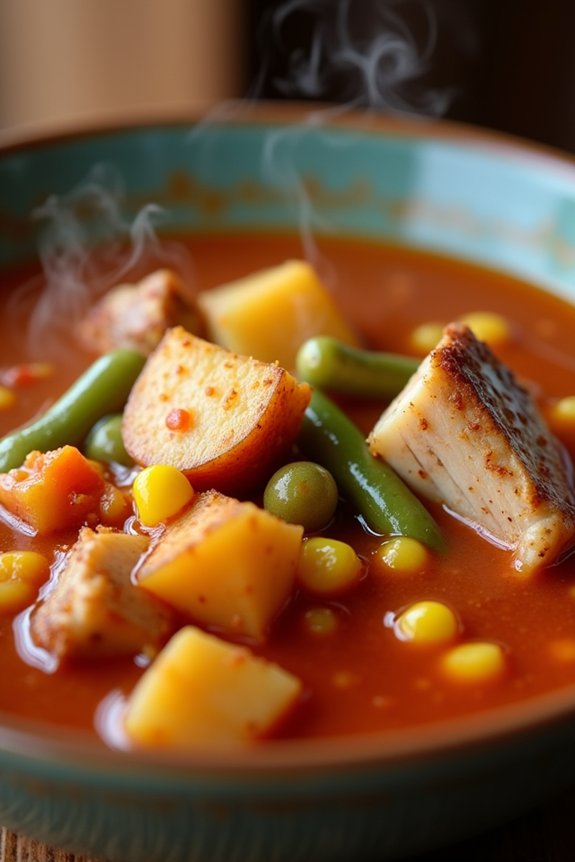
Brunswick Stew is a classic Southern dish with roots in both Virginia and Georgia, each claiming to be the origin of this hearty and flavorful stew. Traditionally, this stew was made with whatever game meat was available, such as squirrel or rabbit. However, in modern times, chicken and pork are more commonly used.
Brunswick Stew is known for its thick, tomato-based broth, loaded with tender meats and a colorful array of vegetables, making it a comforting and satisfying meal, perfect for chilly days or family gatherings.
This recipe serves 4-6 people and combines tender chicken and pork with a medley of vegetables, including lima beans, corn, and potatoes, all simmered together to create a deliciously rich and savory stew. The addition of barbecue sauce and Worcestershire sauce adds depth and a hint of smokiness, making this dish an unforgettable experience.
Brunswick Stew is best cooked slowly, allowing the flavors to meld beautifully, resulting in a soul-warming dish that’s sure to be a hit at your table.
Ingredients:
- 1 pound boneless, skinless chicken thighs
- 1 pound pork shoulder, trimmed and cut into 1-inch cubes
- 2 tablespoons vegetable oil
- 1 large onion, chopped
- 2 cloves garlic, minced
- 1 (28-ounce) can crushed tomatoes
- 4 cups chicken broth
- 1 cup frozen lima beans
- 1 cup frozen corn
- 2 medium russet potatoes, peeled and diced
- 1/4 cup barbecue sauce
- 1 tablespoon Worcestershire sauce
- 1 tablespoon brown sugar
- 1 teaspoon salt
- 1/2 teaspoon black pepper
- 1/2 teaspoon smoked paprika
- Hot sauce, to taste (optional)
Cooking Instructions:
1. Prepare the Meat: Begin by seasoning the chicken thighs and pork shoulder cubes with salt and black pepper. Heat the vegetable oil in a large Dutch oven or heavy-bottomed pot over medium-high heat.
Add the chicken and pork in batches to avoid overcrowding, and brown them on all sides. Once browned, remove the meat from the pot and set it aside.
2. Sauté Aromatics: In the same pot, add the chopped onion and minced garlic. Sauté for about 3-4 minutes, or until the onion becomes translucent and the garlic is fragrant, taking care not to burn the garlic.
3. Build the Stew Base: Return the browned chicken and pork to the pot. Add the crushed tomatoes, chicken broth, barbecue sauce, Worcestershire sauce, and brown sugar. Stir to combine all the ingredients, scraping any browned bits from the bottom of the pot for extra flavor.
4. Simmer the Stew: Bring the stew to a gentle boil, then reduce the heat to low. Cover the pot and let it simmer for about 1 hour, stirring occasionally. This will allow the flavors to develop and the meats to become tender.
5. Add Vegetables: After an hour, add the diced potatoes, lima beans, and corn to the stew. Stir well and continue to simmer for another 30-40 minutes, or until the potatoes are cooked through and all the flavors have melded together.
6. Season and Finalize: Taste the stew and adjust the seasoning with additional salt, pepper, and smoked paprika. If you prefer a bit of heat, add hot sauce to taste. Allow the stew to simmer for an additional 5-10 minutes to confirm the flavors are well incorporated.
7. Serve: Once the stew is ready, serve it hot in bowls, garnished with fresh parsley if desired. Enjoy the comforting warmth and rich flavors of this classic Brunswick Stew.
Extra Tips:
For a richer flavor, consider using bone-in chicken pieces, which can be removed after cooking to shred the meat. The bones add extra depth to the stew’s broth.
Additionally, feel free to customize the vegetable mix to your liking—green beans or carrots can also be great additions. If you prefer a thicker stew, you can mash some of the cooked potatoes with a fork and stir them back into the pot.
Finally, Brunswick Stew can be made a day in advance, as the flavors tend to develop further when allowed to sit overnight.
New England Clam Chowder
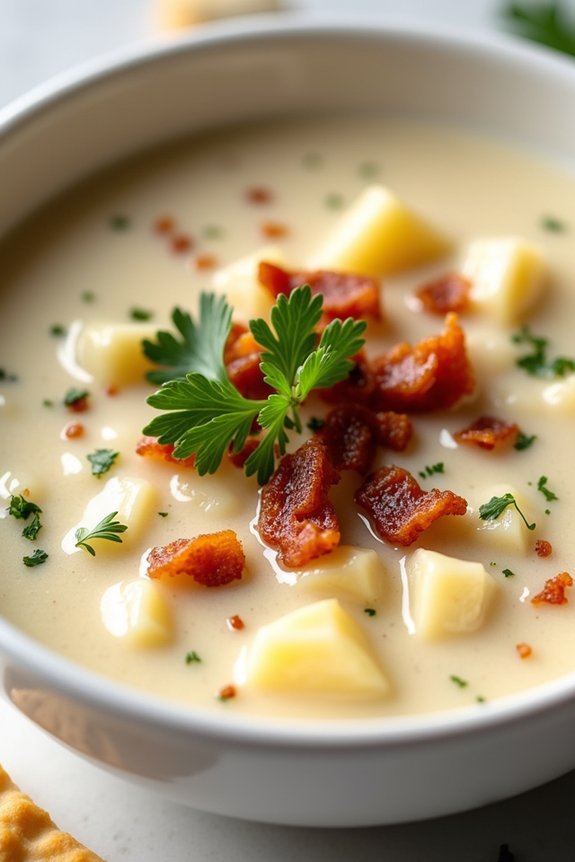
New England Clam Chowder is a timeless American classic, celebrated for its creamy texture and rich flavors. Originating from the Northeastern United States, this hearty stew is a staple in many households and is especially popular during the colder months. The chowder is traditionally characterized by its use of fresh clams, potatoes, and a creamy milk or cream base, making it a comforting and satisfying dish.
The history of New England Clam Chowder dates back to the early 1700s, and it has since evolved into a beloved culinary tradition, with each family adding their unique twist.
The key to a great New England Clam Chowder lies in the quality of its ingredients and the method of preparation. Fresh clams are essential for the best flavor, and the chowder is often enhanced with salted pork or bacon for an added depth of taste. Potatoes add substance and help thicken the stew, while onions and celery provide a subtle aromatic base. A touch of thyme and bay leaves typically rounds out the flavor profile. This recipe serves 4-6 people, making it perfect for family dinners or gatherings with friends.
Ingredients for 4-6 servings:
- 2 dozen fresh clams (such as littleneck or cherrystone)
- 4 slices of bacon or 1/4 cup of salted pork, diced
- 1 medium onion, finely chopped
- 2 stalks of celery, diced
- 2 medium potatoes, peeled and diced
- 3 cups of whole milk
- 1 cup of heavy cream
- 1 tablespoon of all-purpose flour
- 1/2 teaspoon of dried thyme
- 1 bay leaf
- Salt and pepper to taste
- 2 tablespoons of butter
- Fresh parsley for garnish (optional)
Cooking Instructions:
- Prepare the Clams: Start by scrubbing the clams under cold water to remove any sand or grit. In a large pot, add the clams with 2 cups of water. Cover and steam over medium heat for 5-7 minutes, until the clams open. Discard any that remain closed. Strain the clam broth through a fine sieve to remove any sand, and reserve it. Remove the clams from their shells and chop them coarsely.
- Cook the Bacon: In a large pot or Dutch oven, cook the diced bacon or salted pork over medium heat until it’s crispy. Remove with a slotted spoon and set aside, leaving the rendered fat in the pot.
- Sauté the Vegetables: Add the butter to the pot with the bacon fat. Once melted, add the chopped onion and celery. Sauté for about 5 minutes until the vegetables are soft and translucent.
- Add the Potatoes and Broth: Stir in the diced potatoes, thyme, and bay leaf. Pour in the reserved clam broth and enough water to cover the potatoes. Bring to a simmer and cook for about 10 minutes, or until the potatoes are tender.
- Thicken the Chowder: In a small bowl, whisk together the flour with a little milk to create a slurry. Add this mixture to the pot, stirring continuously to avoid lumps. Cook for another 5 minutes until the chowder begins to thicken.
- Add Milk and Cream: Slowly pour in the whole milk and heavy cream, stirring to combine. Add the chopped clams and bacon back into the pot. Heat the chowder gently, but don’t let it boil, to prevent curdling. Season with salt and pepper to taste.
- Serve: Remove the bay leaf and discard. Ladle the chowder into bowls, garnishing with chopped fresh parsley if desired. Serve hot with crusty bread or oyster crackers.
Extra Tips:
For the best flavor, always use fresh clams, but if they’re unavailable, canned clams can be a convenient alternative. Be sure to adjust the salt content if using canned clams, as they can be saltier.
When thickening the chowder, make certain the slurry is well mixed to prevent flour lumps. If you prefer a thicker consistency, you can mash some of the potatoes before adding the milk and cream.
Creole Gumbo
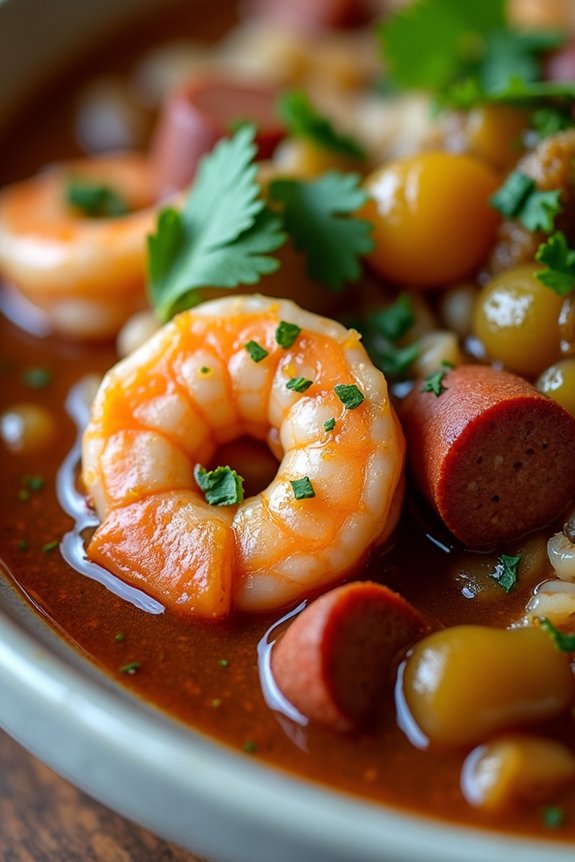
Creole Gumbo is a classic American stew with roots deeply embedded in the rich culinary traditions of Louisiana. This hearty dish is a melting pot of flavors, combining vegetables, seafood, and meats with a rich, flavorful broth.
Gumbo is celebrated for its versatility and ability to warm the soul. Whether served at a festive gathering or enjoyed as a comforting family meal, Creole Gumbo is a delightful representation of Southern hospitality and culinary ingenuity.
This recipe serves 4-6 people and captures the essence of Creole cooking. The blend of spices, the trinity of vegetables, and the combination of proteins create a dish that’s both robust and satisfying. While making gumbo might seem intimidating, it’s an achievable task with the right ingredients and a bit of patience.
Follow the instructions below to create an authentic Creole Gumbo that will impress even the most discerning palate.
Ingredients:
- 1/2 cup vegetable oil
- 1/2 cup all-purpose flour
- 1 large onion, chopped
- 1 bell pepper, chopped
- 2 celery stalks, chopped
- 3 cloves garlic, minced
- 1 pound andouille sausage, sliced
- 1 pound boneless, skinless chicken thighs, cut into bite-sized pieces
- 2 bay leaves
- 1 teaspoon thyme
- 1 teaspoon paprika
- 1 teaspoon cayenne pepper
- 1 teaspoon salt
- 1/2 teaspoon black pepper
- 4 cups chicken stock
- 1 pound shrimp, peeled and deveined
- 1 cup chopped okra
- 2 green onions, sliced
- 1/4 cup fresh parsley, chopped
- Cooked white rice, for serving
Cooking Instructions:
- Prepare the Roux: In a large, heavy-bottomed pot, heat the vegetable oil over medium heat. Gradually whisk in the flour, stirring constantly to make a roux. Continue to stir until the roux turns a deep brown color, similar to chocolate, which should take about 20-25 minutes. Be careful not to burn it.
- Cook the Vegetables: Once the roux is ready, add the chopped onion, bell pepper, and celery to the pot. Cook the vegetables, stirring occasionally, until they’re softened, about 5-7 minutes. Add the minced garlic and cook for an additional minute.
- Add the Meats: Stir in the sliced sausage and chicken pieces. Cook until the chicken is browned on all sides, about 5 minutes.
- Season and Simmer: Add the bay leaves, thyme, paprika, cayenne pepper, salt, and black pepper to the pot. Pour in the chicken stock and bring the mixture to a boil. Once boiling, reduce the heat to low and let it simmer uncovered for 45 minutes, stirring occasionally.
- Add Shrimp and Okra: Stir in the shrimp and okra, and continue to simmer for another 10 minutes, or until the shrimp are pink and cooked through.
- Finish and Serve: Remove the bay leaves and stir in the green onions and parsley. Taste and adjust seasoning if necessary. Serve the gumbo hot over cooked white rice.
Extra Tips:
When making gumbo, patience is key, especially with the roux. The color and flavor of your roux will greatly impact the final taste of the gumbo, so take your time cooking it to the right shade.
Also, if you prefer a thicker gumbo, you can simmer it a bit longer to allow the flavors to further meld and the broth to reduce. Feel free to experiment with different proteins, like crab or different types of sausage, to personalize your gumbo.
Enjoy your culinary journey into the heart of Creole cuisine!
Corned Beef and Cabbage Stew
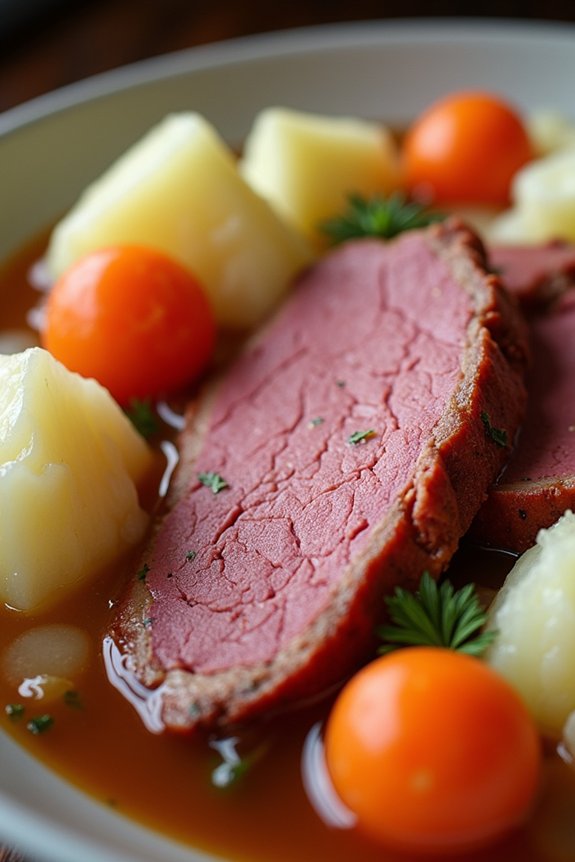
Corned Beef and Cabbage Stew is a beloved classic American dish that combines hearty flavors with a comforting warmth. This stew is traditionally enjoyed during St. Patrick’s Day celebrations, but its rich taste and satisfying textures make it a perfect meal for any cold day.
With its origins deeply rooted in Irish-American culture, the dish is a wonderful blend of tender corned beef, vibrant cabbage, and a mix of vegetables, all simmered to perfection in a flavorful broth.
The beauty of Corned Beef and Cabbage Stew lies in its simplicity. With minimal ingredients and an uncomplicated cooking process, even novice cooks can easily recreate this delicious meal in their own kitchens. The savory aroma that fills the house as the stew simmers is enough to bring everyone to the table.
Served with crusty bread or traditional soda bread, this dish is a wholesome and satisfying meal for families and friends to enjoy together.
Ingredients for 4-6 servings:
- 2 pounds of corned beef brisket, with spice packet
- 10 cups of water
- 1 bay leaf
- 1 teaspoon black peppercorns
- 1 teaspoon mustard seeds
- 6 carrots, peeled and cut into 2-inch pieces
- 6 potatoes, peeled and quartered
- 1 onion, quartered
- 1 small head of cabbage, cut into wedges
- Salt and pepper to taste
Cooking Instructions:
- Prepare the Corned Beef: Rinse the corned beef brisket under cold water to remove excess salt and place it in a large pot or Dutch oven. Add 10 cups of water, spice packet, bay leaf, black peppercorns, and mustard seeds to the pot.
- Simmer the Beef: Bring the water to a boil over medium-high heat. Once boiling, reduce the heat to low, cover the pot, and allow the corned beef to simmer for about 2.5 hours. This slow cooking process helps tenderize the meat and infuse it with the spices.
- Add Vegetables: After 2.5 hours, add the carrots, potatoes, and onion to the pot. Let them cook with the corned beef for an additional 30 minutes.
- Cook the Cabbage: Add the cabbage wedges to the pot and continue to simmer for another 15-20 minutes, or until the cabbage and other vegetables are tender.
- Check and Adjust Seasoning: Taste the broth and adjust seasoning with salt and pepper if necessary.
- Serve: Remove the corned beef from the pot, slice it against the grain, and serve it alongside the vegetables, ladling the flavorful broth over the dish.
Extra Tips:
For the best flavor, try to use fresh, high-quality corned beef brisket. If time allows, prepare the stew a day in advance and allow it to sit overnight in the refrigerator. This resting period enhances the flavors, making the dish even more delicious when reheated.
Additionally, make certain that the vegetables aren’t overcooked; they should be tender but still hold their shape. If you prefer a thicker broth, mash a few potatoes into the liquid to create a heartier consistency. Enjoy your Corned Beef and Cabbage Stew with a slice of warm soda bread for a truly comforting meal.
Kentucky Burgoo
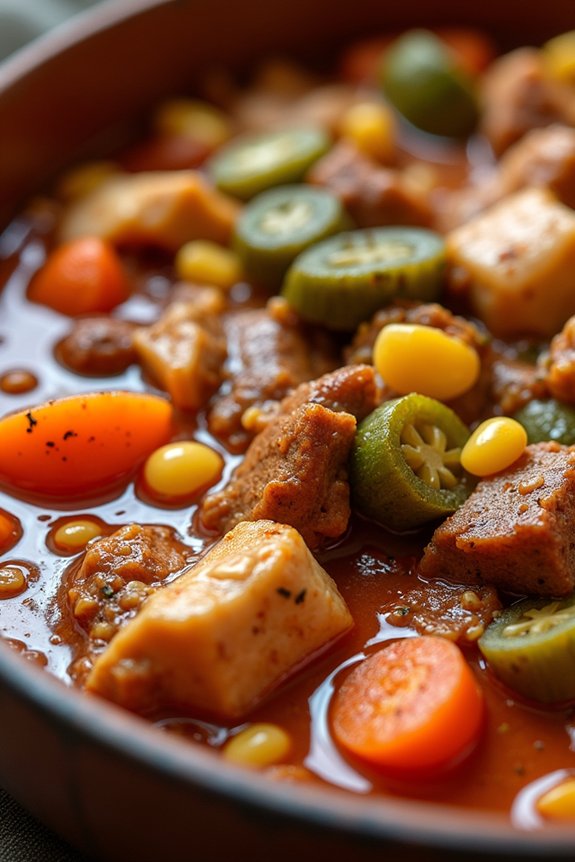
Kentucky Burgoo is a traditional American stew that originates from the Bluegrass State. Known for its rich, flavorful blend of meats and vegetables, this hearty dish was originally served at large gatherings such as community events and horse races. The origins of burgoo are somewhat mysterious, but it’s believed to have been influenced by the French stew called “ragout.”
This dish is perfect for feeding a crowd, and its versatility allows for the use of various meats and vegetables, making it adaptable to seasonal ingredients. The preparation of Kentucky Burgoo involves a slow-cooking process that melds the flavors of multiple meats, such as chicken, beef, and pork, with an array of vegetables, including potatoes, corn, and okra.
The result is a thick, delicious stew that embodies the essence of Southern cooking. Whether served at a derby party or a cozy family dinner, Kentucky Burgoo is a dish that warms the heart and satisfies the soul.
Ingredients (Serves 4-6):
- 1 pound chicken thighs, boneless and skinless
- 1 pound beef chuck, cut into cubes
- 1/2 pound pork shoulder, cut into cubes
- 4 cups chicken broth
- 2 tablespoons vegetable oil
- 2 onions, chopped
- 3 cloves garlic, minced
- 3 carrots, chopped
- 3 celery stalks, chopped
- 2 potatoes, peeled and diced
- 1 cup corn kernels (fresh or frozen)
- 1 cup okra, sliced
- 1 can (14 oz) crushed tomatoes
- 2 bay leaves
- 1 teaspoon dried thyme
- 1 teaspoon smoked paprika
- Salt and pepper to taste
- 1 tablespoon Worcestershire sauce
- 1 tablespoon apple cider vinegar
Cooking Instructions:
1. Prepare the Meats: In a large pot or Dutch oven, heat the vegetable oil over medium-high heat. Add the chicken thighs and cook until browned on both sides, about 5 minutes per side. Remove the chicken and set aside.
Repeat the process with the beef and pork, browning them in batches to avoid overcrowding the pot. Remove and set aside with the chicken.
2. Sauté the Vegetables: In the same pot, add the chopped onions, garlic, carrots, and celery. Cook until the vegetables are softened, about 7-10 minutes. Stir occasionally to prevent sticking.
3. Combine Ingredients: Return the browned meats to the pot. Add the chicken broth, crushed tomatoes, potatoes, corn, okra, bay leaves, thyme, smoked paprika, Worcestershire sauce, and apple cider vinegar. Stir to combine all ingredients evenly.
4. Simmer the Stew: Bring the mixture to a boil, then reduce the heat to low. Cover the pot and let the stew simmer for 2 to 3 hours, stirring occasionally. This slow cooking process allows the flavors to meld together and the meats to become tender.
5. Final Seasoning: After the stew has cooked, taste and adjust the seasoning with salt and pepper. Remove the bay leaves before serving.
6. Serve: Ladle the burgoo into bowls and serve hot. This stew pairs well with rustic bread or cornbread for a complete, hearty meal.
Extra Tips:
When preparing Kentucky Burgoo, consider using a slow cooker for added convenience. Simply brown the meats and sauté the vegetables on the stovetop, then transfer everything to the slow cooker and let it cook on low for 6-8 hours.
This method guarantees the meats are tender and the flavors are deeply infused. Additionally, feel free to experiment with different meats and vegetables based on availability and preference. Rabbit or game meats can be used for a more traditional version, and any seasonal vegetables can be added to personalize your burgoo further.
Texas Chili
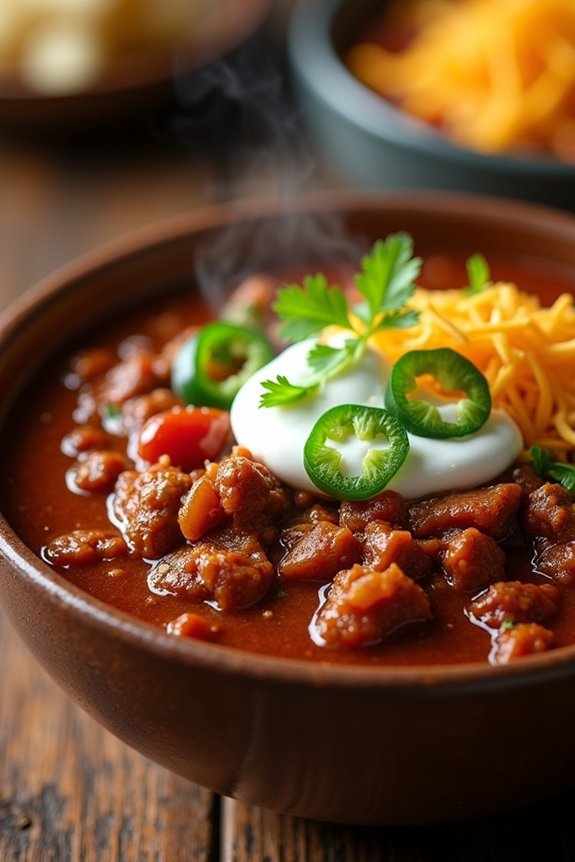
Texas Chili, a staple in classic American stew recipes, is a hearty and flavorful dish known for its robust, spicy taste and rich texture. Unlike many chili recipes that include beans, Texas Chili is all about the meat and spices, creating a dish that’s deeply satisfying and perfect for cool evenings.
Originating from the Lone Star State, this chili is beloved for its simplicity and reliance on quality ingredients to bring out the best flavors. This recipe serves 4-6 people and emphasizes the traditional approach of using chunks of beef and a combination of chilies to create a depth of flavor.
The combination of slow-cooked meat and bold spices will have your kitchen filled with mouthwatering aromas, and the end result is a bowl of chili that offers warmth and comfort. Perfect for gatherings or a cozy family meal, Texas Chili is sure to become a favorite in your household.
Ingredients:
- 2 pounds beef chuck, cut into 1-inch cubes
- 2 tablespoons vegetable oil
- 1 large onion, chopped
- 4 cloves garlic, minced
- 2 tablespoons chili powder
- 1 tablespoon ground cumin
- 1 tablespoon smoked paprika
- 1 teaspoon dried oregano
- 1 teaspoon cayenne pepper
- 1 teaspoon salt
- 1/2 teaspoon black pepper
- 2 cups beef broth
- 1 cup crushed tomatoes
- 2 tablespoons tomato paste
- 2 tablespoons apple cider vinegar
- 1 tablespoon Worcestershire sauce
- Optional toppings: shredded cheese, sour cream, chopped cilantro, sliced jalapeños
Cooking Instructions:
- Prepare the Meat: Begin by heating 1 tablespoon of vegetable oil in a large pot over medium-high heat. Add the beef cubes in batches, browning them on all sides. Don’t overcrowd the pot. Once browned, remove the beef with a slotted spoon and set it aside.
- Sauté Aromatics: Reduce the heat to medium and add the remaining tablespoon of oil to the pot. Add the chopped onion and cook until translucent, about 5 minutes. Stir in the minced garlic and cook for an additional minute until fragrant.
- Spice it Up: Return the browned beef to the pot. Sprinkle the chili powder, ground cumin, smoked paprika, oregano, cayenne pepper, salt, and black pepper over the meat and onion mixture. Stir to coat everything evenly with the spices.
- Simmer the Chili: Pour in the beef broth, crushed tomatoes, and tomato paste. Stir well to combine. Bring the mixture to a boil, then reduce the heat to low. Cover the pot and let the chili simmer gently for about 1.5 to 2 hours, stirring occasionally, until the beef is tender and the flavors have melded together.
- Final Touches: About 15 minutes before serving, stir in the apple cider vinegar and Worcestershire sauce. Taste the chili and adjust seasoning if necessary.
- Serve and Garnish: Serve the Texas Chili hot, garnished with optional toppings such as shredded cheese, sour cream, chopped cilantro, and sliced jalapeños for added flavor and texture.
Extra Tips:
When cooking Texas Chili, patience is key. Allowing the chili to simmer slowly guarantees that the beef becomes tender and the flavors develop fully.
If you prefer a thicker chili, you can let it simmer uncovered for the last 30 minutes, allowing some of the liquid to evaporate. For those who like an extra kick, consider adding fresh diced jalapeños during the cooking process.
Oyster Stew
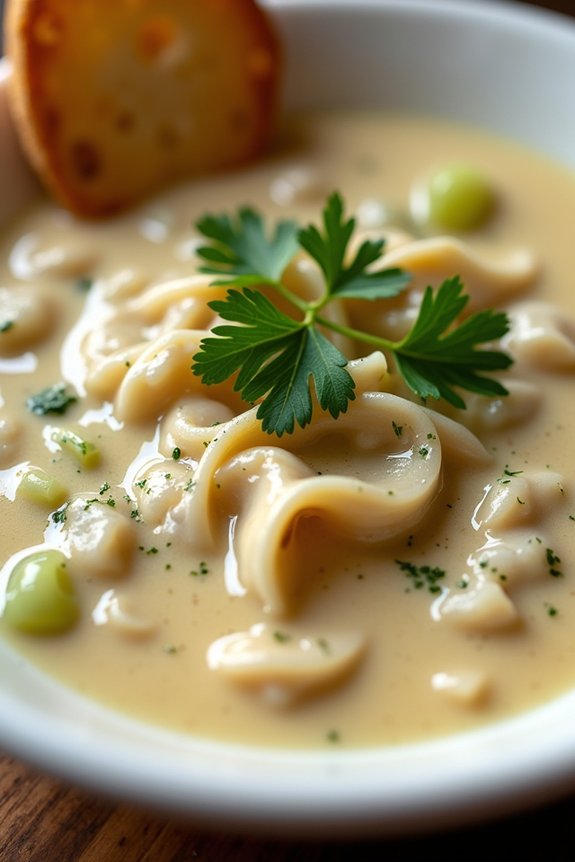
Oyster stew is a classic American dish that’s both simple and comforting, often enjoyed during the colder months or as a special holiday treat. This creamy, savory stew is rich in flavor and has a silky texture, making it a favorite for many seafood lovers.
Originating from the East Coast, particularly in regions with abundant oyster harvests, it has become a staple in many American households. Preparing this dish involves cooking fresh oysters gently in a buttery, milky broth, which allows the natural flavors of the oysters to shine through.
This oyster stew recipe is designed to serve 4-6 people, making it perfect for a family dinner or a small gathering. The key to a great oyster stew is using fresh, high-quality oysters and taking care to not overcook them, preserving their delicate texture and taste.
The stew is traditionally seasoned with simple ingredients like salt, pepper, and a touch of celery salt to enhance its flavor, but you can also add your personal touch with herbs or spices if desired.
Ingredients:
- 2 pints fresh oysters, with their liquor
- 4 cups whole milk
- 1 cup heavy cream
- 1/2 cup unsalted butter
- 1 small onion, finely chopped
- 1 stalk celery, finely chopped
- Salt and white pepper to taste
- 1 teaspoon celery salt
- 1 tablespoon fresh parsley, chopped (optional)
- Oyster crackers or crusty bread, for serving
Cooking Instructions:
- Prepare the Oysters: Begin by draining the oysters, reserving their liquor. Check the oysters for any pieces of shell and remove them. Set both the oysters and the liquor aside for later use.
- Cook the Vegetables: In a large pot, melt the butter over medium heat. Add the finely chopped onion and celery, cooking until they’re soft and translucent, about 5 minutes. Stir occasionally to prevent burning.
- Add Liquids: Pour in the reserved oyster liquor, whole milk, and heavy cream into the pot with the cooked vegetables. Stir gently to combine and allow the mixture to come to a simmer. Don’t let it boil, as this can cause the milk to curdle.
- Add Oysters: Once the mixture is simmering, add the oysters. Cook them gently until the edges curl, which should take about 3-5 minutes. Be careful not to overcook the oysters, as they can become tough.
- Season the Stew: Season the stew with salt, white pepper, and celery salt. Adjust the seasoning to your taste. If using, stir in the fresh parsley at this point.
- Serve: Ladle the oyster stew into bowls and serve immediately. Accompany the stew with oyster crackers or crusty bread for a traditional touch.
Extra Tips:
When preparing oyster stew, freshness is key, so try to purchase oysters from a reputable source and use them as soon as possible.
To enhance the flavor, you can also add a splash of dry white wine or sherry before adding the oysters, allowing the alcohol to cook off slightly. If you prefer a thicker stew, you can make a roux with butter and flour before adding the milk and cream, although traditional recipes usually keep the broth light and creamy.
Finally, remember that oyster stew is best enjoyed immediately after cooking, as reheating can alter the texture of the oysters.
Jambalaya
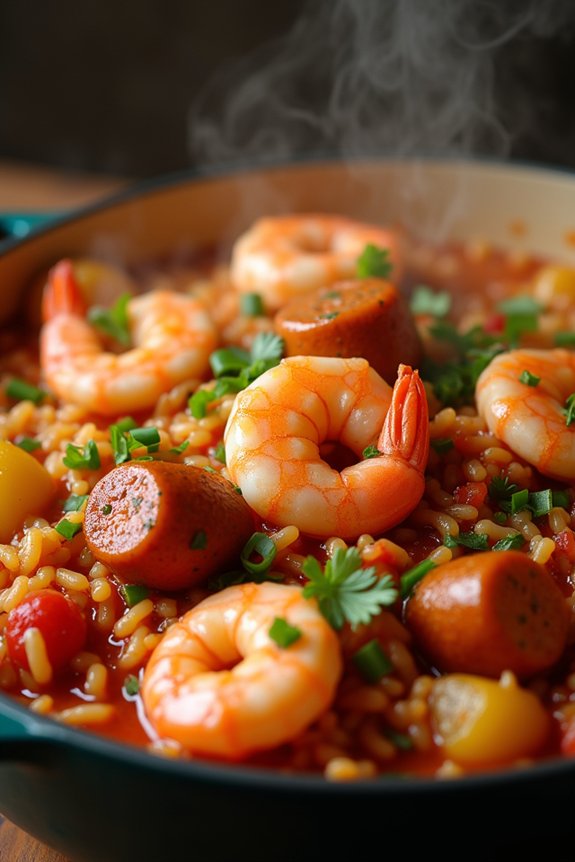
Jambalaya is a classic Creole and Cajun dish that epitomizes the vibrant culinary traditions of Louisiana. This hearty stew is a delicious concoction of rice, vegetables, spices, and a medley of meats or seafood. The origins of jambalaya are a fascinating blend of Spanish, French, and African influences, making it a true representation of the cultural melting pot of the American South.
Traditionally cooked in a single pot, this dish is perfect for gatherings and offers a symphony of flavors that delight the palate with every bite. The key to an authentic jambalaya lies in its rich and flavorful base, built upon the “Holy Trinity” of Creole cooking: onions, bell peppers, and celery.
It’s a versatile dish that allows for creativity, often featuring chicken, andouille sausage, shrimp, or a combination of all three. The spices are what give jambalaya its signature kick – a mix of cayenne, paprika, and thyme that brings warmth and depth to the dish. Whether you’re hosting a lively Mardi Gras celebration or simply craving a comforting meal, this recipe will transport you straight to the heart of Louisiana.
Ingredients (Serving Size: 4-6 people):
- 2 tablespoons olive oil
- 1 pound boneless, skinless chicken thighs, cut into chunks
- 1 pound andouille sausage, sliced
- 1 onion, diced
- 1 green bell pepper, diced
- 2 stalks celery, diced
- 3 cloves garlic, minced
- 1 cup long-grain white rice
- 1 (14.5-ounce) can diced tomatoes
- 2 cups chicken broth
- 1 teaspoon dried thyme
- 1 teaspoon smoked paprika
- 1/2 teaspoon cayenne pepper
- Salt and pepper to taste
- 1 pound medium shrimp, peeled and deveined
- 2 green onions, sliced
- Fresh parsley, chopped (for garnish)
Cooking Instructions:
- Prepare the Base: Heat the olive oil in a large, heavy-bottomed pot over medium-high heat. Add the chicken thighs and andouille sausage. Cook until the chicken is browned on all sides and the sausage is slightly crispy, about 5-7 minutes. Remove the meat from the pot and set aside.
- Sauté the Vegetables: In the same pot, add the diced onion, bell pepper, and celery. Sauté until the vegetables are soft and translucent, about 5 minutes. Stir in the minced garlic and cook for another minute until fragrant.
- Add the Rice and Tomatoes: Stir in the rice, ensuring it’s well-coated with the oil and vegetable mixture. Add the can of diced tomatoes with their juices, and cook for 2 minutes, stirring occasionally.
- Combine with Broth and Spices: Pour in the chicken broth and add the thyme, smoked paprika, cayenne pepper, salt, and pepper. Stir well to combine all ingredients.
- Simmer the Jambalaya: Return the chicken and sausage to the pot. Bring the mixture to a boil, then reduce the heat to low. Cover and let it simmer for about 25 minutes, or until the rice is cooked and has absorbed most of the liquid.
- Add the Shrimp: Gently fold in the shrimp, cover, and cook for an additional 5 minutes, or until the shrimp are pink and cooked through.
- Finish and Serve: Remove the pot from the heat. Sprinkle the sliced green onions and chopped parsley over the top. Let the jambalaya sit for a few minutes to allow the flavors to meld before serving.
Extra Tips:
For a more flavorful jambalaya, consider using homemade chicken broth or adding a splash of Worcestershire sauce. If you prefer a smokier taste, increase the smoked paprika or try adding a dash of liquid smoke.
Adjust the level of cayenne pepper to suit your taste for spice. Remember that jambalaya is a forgiving dish, so feel free to substitute or add other proteins like ham or crab. Finally, be patient with the simmering process, as it allows the rice to soak up all the wonderful flavors. Enjoy your culinary journey to Louisiana!
Pennsylvania Dutch Chicken Pot Pie
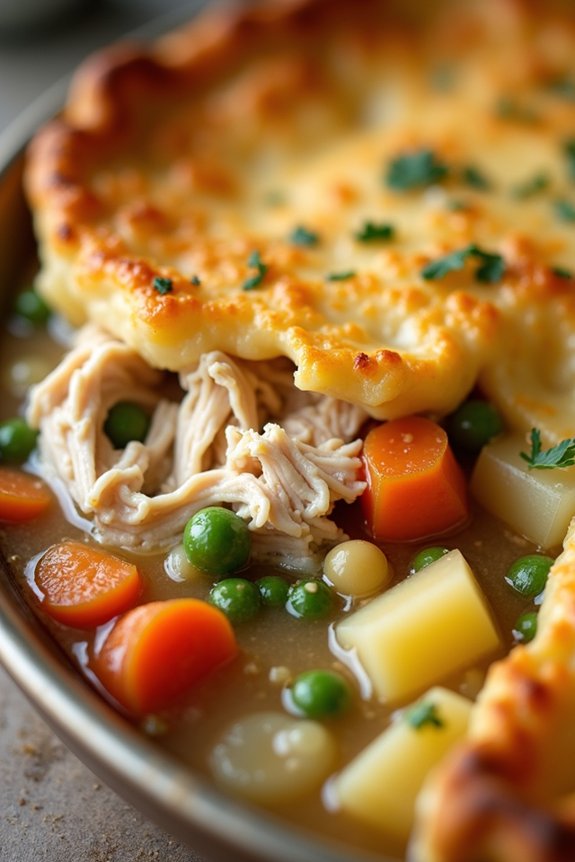
Pennsylvania Dutch Chicken Pot Pie is a hearty and comforting dish that’s quite different from the traditional pot pie with a crust. This delightful stew hails from the Pennsylvania Dutch country and features a savory broth filled with tender chicken, vegetables, and homemade noodles. It’s a perfect meal for a cozy family dinner, especially during colder months. The homemade noodles are what set this dish apart, as they soak up the flavorful broth, creating a satisfying and filling meal.
The origins of Pennsylvania Dutch Chicken Pot Pie can be traced back to the German immigrants who settled in Pennsylvania. Their influence is apparent in the simplicity and heartiness of the meal, which is designed to feed a family using basic, affordable ingredients. This recipe for Pennsylvania Dutch Chicken Pot Pie serves 4 to 6 people, making it an ideal choice for a family gathering or for leftovers to enjoy throughout the week.
Ingredients:
- 1 whole chicken (about 3-4 pounds)
- 8 cups chicken broth
- 2 cups water
- 2 cups all-purpose flour
- 2 large eggs
- 1/4 cup milk
- 1 teaspoon salt
- 1/2 teaspoon ground black pepper
- 2 cups diced potatoes
- 2 cups sliced carrots
- 1 cup chopped celery
- 1 cup chopped onion
- 1 cup frozen peas
- 2 tablespoons chopped fresh parsley (optional)
Instructions:
- Prepare the Chicken: Place the whole chicken in a large pot and cover it with chicken broth and water. Bring to a boil over medium-high heat, then reduce the heat to low and simmer for about 1 to 1.5 hours, or until the chicken is fully cooked and tender. Skim off any foam that rises to the top during cooking.
- Remove and Shred Chicken: Once the chicken is cooked, remove it from the pot and allow it to cool slightly. Remove the meat from the bones, discarding the skin and bones. Shred the chicken into bite-sized pieces and set aside.
- Make the Noodles: In a mixing bowl, combine the flour, eggs, milk, and 1/2 teaspoon of salt. Mix until a stiff dough forms. Roll out the dough on a floured surface to about 1/8-inch thickness. Cut the dough into 2-inch squares or rectangles to make the noodles.
- Cook the Vegetables: Return the pot with broth to the stove. Add potatoes, carrots, celery, and onions to the broth. Simmer for about 10 minutes or until the vegetables are tender.
- Add Noodles and Chicken: Gently add the noodles to the simmering broth and vegetables. Cook for another 10 to 12 minutes, or until the noodles are cooked through and tender. Stir occasionally to prevent sticking. Add the shredded chicken back into the pot along with the frozen peas. Season with the remaining salt and pepper to taste.
- Finish the Dish: Allow the pot pie to simmer for an additional 5 minutes to guarantee everything is heated through. Stir in fresh parsley if using, and adjust seasoning as needed.
Extra Tips:
To save time, you can use pre-cooked rotisserie chicken and store-bought chicken broth. Just simmer the vegetables and follow the same steps for making the noodles.
For a richer flavor, consider adding a bay leaf or a pinch of thyme when cooking the broth. Always taste and adjust the seasoning before serving to confirm the flavors are balanced.
If you prefer a thicker broth, mix a tablespoon of cornstarch with cold water and add it to the pot before adding the chicken to achieve your desired consistency.
Manhattan Clam Chowder
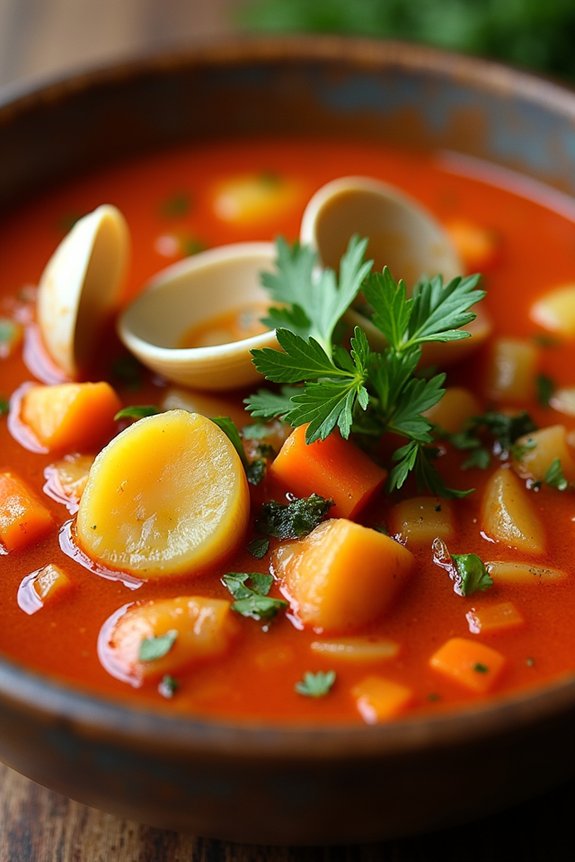
Manhattan Clam Chowder is a hearty, flavorful stew that highlights the delicious taste of clams combined with the richness of tomatoes and the earthiness of vegetables. Unlike its creamy cousin from New England, this version of clam chowder is made with a tomato base, giving it a vibrant red color and a slightly tangy flavor. The dish is perfect for warming up on a chilly evening and offers a delightful taste of the sea with every spoonful.
This recipe is designed to serve 4-6 people, making it ideal for a family dinner or a small gathering of friends. The preparation involves fresh clams, aromatic vegetables, and a blend of herbs that infuse the stew with a savory depth. With the right balance of ingredients, you’ll be able to create a classic American dish that’s both nutritious and satisfying.
Ingredients:
- 3 dozen fresh clams, scrubbed
- 4 cups clam juice or fish stock
- 2 tablespoons olive oil
- 1 large onion, diced
- 2 cloves garlic, minced
- 2 celery stalks, diced
- 2 carrots, diced
- 1 large potato, peeled and diced
- 1 can (14.5 oz) diced tomatoes, with juice
- 1 tablespoon tomato paste
- 1 teaspoon dried thyme
- 1 teaspoon dried oregano
- 1/4 teaspoon red pepper flakes (optional)
- Salt and pepper to taste
- 2 tablespoons chopped fresh parsley
- 1 bay leaf
Cooking Instructions:
- Prepare the Clams: Place the scrubbed clams in a large pot with 4 cups of clam juice or fish stock. Cover and bring to a boil over high heat. Cook until the clams open, about 5-7 minutes. Remove the clams with a slotted spoon and set aside to cool. Strain the clam broth through a fine mesh sieve lined with cheesecloth to remove any grit. Set the broth aside.
- Sauté the Aromatics: In a large pot, heat the olive oil over medium heat. Add the diced onion, garlic, celery, and carrots. Sauté until the vegetables are softened, about 5 minutes.
- Add Potatoes and Tomatoes: Stir in the diced potato, canned tomatoes with their juice, and tomato paste. Mix well to combine.
- Incorporate the Herbs and Broth: Add the strained clam broth, thyme, oregano, red pepper flakes, salt, and pepper. Drop in the bay leaf. Bring the mixture to a simmer and cook until the potatoes are tender, about 15-20 minutes.
- Add Clams and Finish: Once the clams are cool enough to handle, remove them from their shells and chop them into bite-sized pieces. Add the chopped clams to the pot and heat through for about 5 minutes. Remove the bay leaf.
- Serve: Ladle the chowder into bowls, sprinkle with chopped fresh parsley, and serve hot.
Extra Tips:
When preparing Manhattan Clam Chowder, make certain that you thoroughly clean the clams to remove any sand or grit. It’s a good idea to soak them in cold water with a bit of cornmeal or salt to help them expel any remaining grit.
Additionally, if fresh clams are unavailable, you can substitute with canned clams and use bottled clam juice, but fresh is always best for the most authentic flavor. Adjust the seasoning to your taste, and if you prefer a spicier chowder, feel free to increase the red pepper flakes.
Finally, this chowder pairs wonderfully with crusty bread to soak up every last drop of the delicious broth.
Pork and Sauerkraut Stew
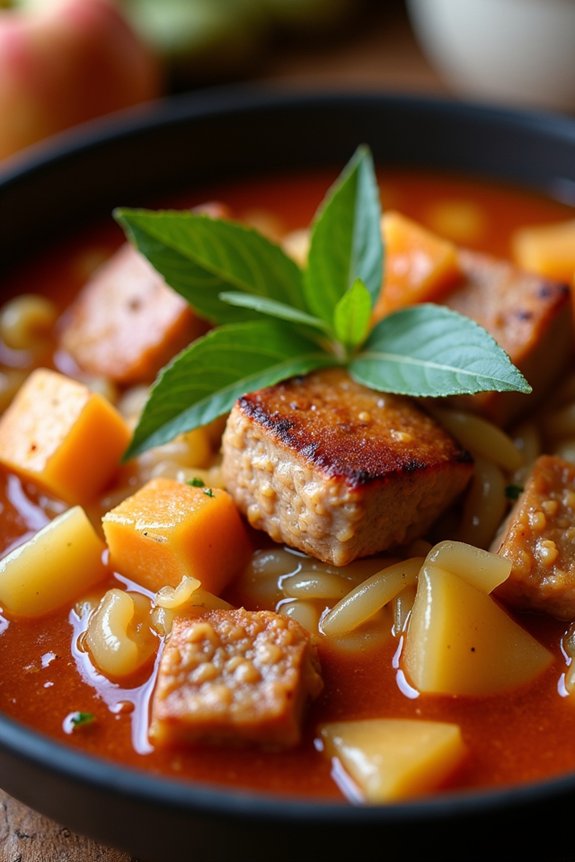
Pork and Sauerkraut Stew is a classic American dish with roots deeply embedded in German and Eastern European culinary traditions. This hearty stew combines the savory flavors of tender pork with the tangy, fermented taste of sauerkraut, creating a comforting dish perfect for a chilly day. The slow cooking process allows the flavors to meld beautifully, resulting in a rich and satisfying meal that’s bound to please the whole family.
Traditionally served with mashed potatoes or hearty bread, this stew is versatile enough to be enjoyed on its own or as part of a larger meal.
The preparation of Pork and Sauerkraut Stew is relatively simple, making it an excellent choice for both novice cooks and experienced chefs alike. The key to this dish lies in the quality of its ingredients, guaranteeing that the pork is tender and the sauerkraut is flavorful without being overly sour.
With a few basic steps and some patience, you can create a delicious stew that will transport you and your guests to a cozy, welcoming kitchen filled with the comforting aromas of this timeless classic.
Ingredients for 4-6 people:
- 2 pounds pork shoulder, cubed
- 1 tablespoon olive oil
- 1 large onion, diced
- 3 cloves garlic, minced
- 1 teaspoon caraway seeds
- 1 teaspoon paprika
- 1/2 teaspoon black pepper
- 1 cup chicken broth
- 2 cups sauerkraut, drained
- 2 tablespoons brown sugar
- 1 apple, peeled, cored, and diced
- 2 bay leaves
- Salt to taste
Cooking Instructions:
- Prepare the Pork: Begin by cutting the pork shoulder into 1-inch cubes. Pat the pieces dry with a paper towel to guarantee a good sear later.
- Sear the Pork: Heat the olive oil in a large Dutch oven or heavy-bottomed pot over medium-high heat. Add the pork cubes in batches, searing each side until browned. Remove the pork from the pot and set aside.
- Cook the Aromatics: In the same pot, add the diced onion and cook until translucent, about 5 minutes. Add the minced garlic, caraway seeds, paprika, and black pepper, stirring continuously for another minute until fragrant.
- Deglaze the Pot: Pour the chicken broth into the pot, scraping any browned bits from the bottom. This will add depth to your stew.
- Combine Ingredients: Return the seared pork to the pot. Stir in the sauerkraut, brown sugar, diced apple, and bay leaves.
- Simmer the Stew: Bring the mixture to a boil, then reduce the heat to low. Cover the pot and let it simmer for 1.5 to 2 hours, or until the pork is tender and the flavors have melded together. Stir occasionally and add salt to taste if needed.
- Finalize and Serve: Remove the bay leaves before serving. Adjust seasoning as necessary and serve the stew hot, accompanied by mashed potatoes or a side of crusty bread.
Extra Tips:
When cooking Pork and Sauerkraut Stew, it’s important to give the dish time for the flavors to fully develop. If you have the time, prepare the stew a day in advance and allow it to rest overnight in the refrigerator. This resting period allows the flavors to intensify and the meat to become even more tender.
Additionally, if you prefer a slightly thicker stew, consider adding a tablespoon of flour or cornstarch slurry towards the end of the cooking process. Finally, don’t forget to taste and adjust the seasoning before serving, as the tanginess of the sauerkraut can vary depending on the brand used.
Mulligan Stew
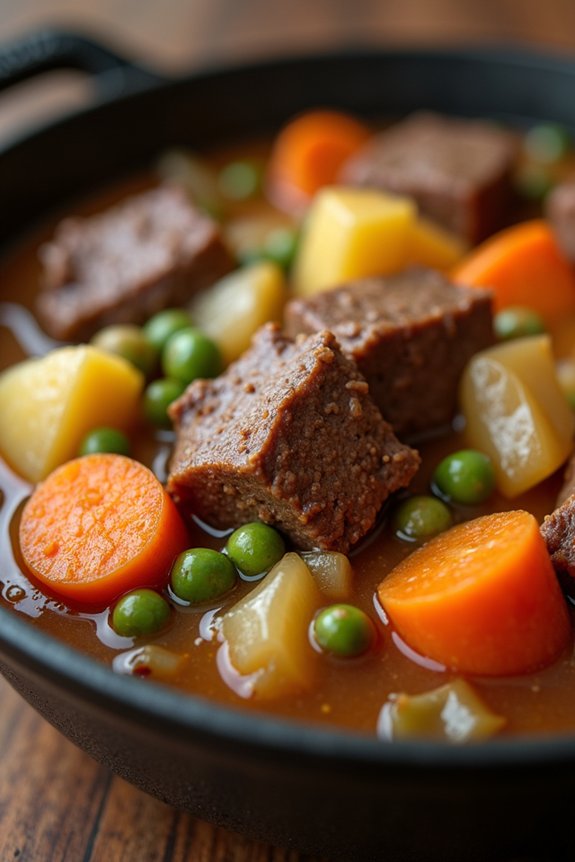
Mulligan Stew is a hearty and versatile dish that has its roots in the hobo community during the Great Depression. Traditionally, it was a way for people to combine whatever ingredients they’d on hand into a filling and comforting meal.
Today, this classic American stew can be adapted with a variety of meats and vegetables, making it a perfect choice for a cold evening or a family gathering. The beauty of Mulligan Stew is that it can be customized to suit your taste and the ingredients you have available, while still offering a rich and satisfying flavor.
This recipe for Mulligan Stew is designed to serve 4-6 people, allowing for a generous portion of this savory dish. The recipe features tender chunks of beef, a medley of vegetables, and a rich broth that brings everything together. By following these straightforward instructions, you’ll be able to create a delicious and comforting meal that everyone will enjoy.
Remember, the key to a great Mulligan Stew is allowing the flavors to meld together, so don’t rush the cooking process.
Ingredients:
- 2 pounds beef stew meat, cubed
- 2 tablespoons olive oil
- 1 large onion, chopped
- 3 cloves garlic, minced
- 4 cups beef broth
- 2 cups water
- 1 can (14.5 ounces) diced tomatoes
- 4 large carrots, sliced
- 3 medium potatoes, peeled and cubed
- 2 stalks celery, sliced
- 1 cup frozen peas
- 1 teaspoon dried thyme
- 1 teaspoon dried oregano
- 1 bay leaf
- Salt and pepper to taste
Cooking Instructions:
- Prepare the Ingredients: Begin by preparing all the vegetables. Chop the onion, mince the garlic, slice the carrots and celery, and cube the potatoes. Having everything ready before you start cooking will make the process smoother.
- Brown the Beef: In a large pot or Dutch oven, heat the olive oil over medium-high heat. Add the cubed beef stew meat in batches, searing each piece until they’re browned on all sides. Remove the beef and set it aside.
- Sauté the Aromatics: In the same pot, add the chopped onion and minced garlic. Sauté until the onion becomes translucent and fragrant, about 5 minutes.
- Combine Ingredients: Return the browned beef to the pot. Add the beef broth, water, and diced tomatoes. Stir in the carrots, potatoes, and celery. Add the thyme, oregano, bay leaf, salt, and pepper. Bring the mixture to a boil.
- Simmer the Stew: Once boiling, reduce the heat to low, cover the pot, and let the stew simmer for about 1.5 to 2 hours. Stir occasionally and check that the meat is tender.
- Finish with Peas: About 10 minutes before serving, add the frozen peas. Stir them into the stew and allow them to heat through.
- Adjust Seasoning: Taste the stew and adjust the seasoning with additional salt and pepper if necessary. Remove the bay leaf before serving.
Extra Tips: For the best flavor, try to use fresh herbs if they’re available, substituting the dried herbs with double the amount of fresh ones.
Additionally, feel free to swap out vegetables based on what you have on hand or what’s in season. If you prefer a thicker stew, you can mash some of the potatoes directly in the pot or add a tablespoon of cornstarch mixed with cold water.
Ultimately, like many stews, Mulligan Stew can taste even better the next day, so consider making it ahead of time.

